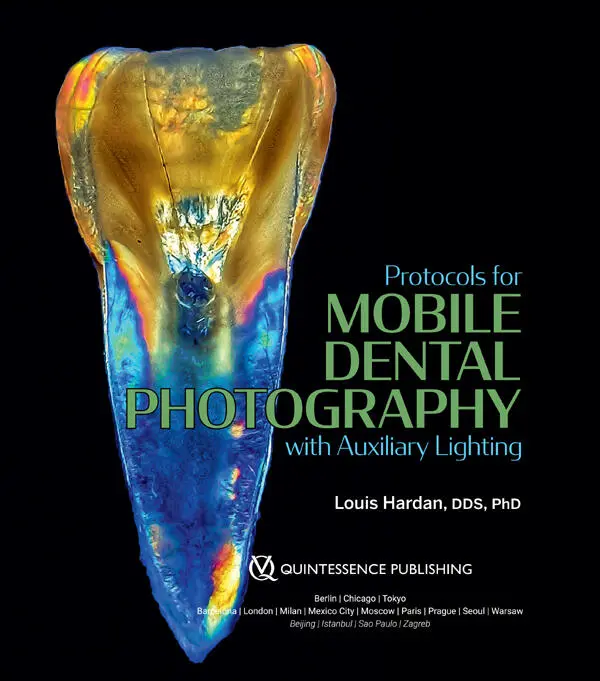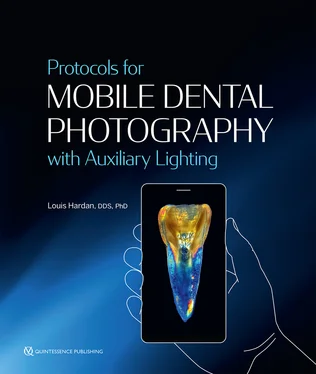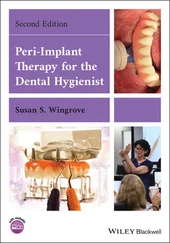Protocols for Mobile Dental Photography with Auxiliary Lighting

Library of Congress Cataloging-in-Publication Data
Names: Hardan, Louis, author.
Title: Protocols for mobile dental photography with auxiliary lighting / Louis Hardan.
Description: Chicago : Quintessence Publishing, 2020. | Includes bibliographical references and index. | Summary: “Demonstrates how to document dental treatment and take artistic photography with a smartphone camera in conjunction with auxiliary lighting”—Provided by publisher.
Identifiers: LCCN 2020020011 | ISBN 9780867159462 (hardcover)
Subjects: MESH: Photography, Dental--methods | Dental Records | Mobile Applications | Smartphone | Lighting
Classification: LCC TR708 | NLM TR 708 | DDC 617.60022/2--dc23
LC record available at https://lccn.loc.gov/2020020011

© 2020 Quintessence Publishing Co, Inc
Quintessence Publishing Co, Inc
411 N Raddant Road
Batavia, IL 60510
www.quintpub.com
5 4 3 2 1
All rights reserved. This book or any part thereof may not be reproduced, stored in a retrieval system, or transmitted in any form or by any means, electronic, mechanical, photocopying, or otherwise, without prior written permission of the publisher.
Editor: Leah Huffman
Design: Sue Zubek
Production: Sarah Minor
Printed in China
CONTENTS
About the Author ABOUT THE AUTHOR Louis Hardan, DDS, PhD, is a professor and the director of the master program in the Restorative and Esthetic Department at Saint Joseph University in Beirut, Lebanon. He received his dental degree in 1989 and continued his postdoctoral education at Saint Joseph University, where he obtained a certificate for basic science in 1993, completed his specialization in restorative and esthetic dentistry in 1995, and completed his PhD in oral biology and materials in 2009. Dr Hardan maintains a private practice in his hometown of Byblos, Lebanon, and he is the scientific director and an honorary and active international member of StyleItaliano. He is also the country chairperson for Lebanon of the European Society of Cosmetic Dentistry. Dr Hardan is the inventor of Smile Lite MDP (Smile Line), a device used to take high-quality dental photographs with a mobile phone, for which he won the Best of Class Technology Award in 2017, as well as Posterior Misura (LM instrument), an instrument for shaping direct posterior composites. He has many publications to his name in international journals and has given several international lectures and courses on esthetics, restorative dentistry, and mobile dental photography.
Foreword FOREWORD “You should never judge a photographer by the type of film used, but only how he uses it.” –Ernst Haas Walter Devoto & Angelo Putignano Founders of StyleItaliano Since Professor Louis S. Hardan joined the StyleItaliano team, every day he has shown the curiosity and interest in simplified dentistry that is in our StyleItaliano DNA. One day he came to us and said, “Taking a good dental photo must be as easy and pleasant as taking a selfie.” We were shocked by this, considering all the effort that goes into taking high-quality photographs in the clinic, all the devices and details required, all the money invested in making the communication better and better in our courses and lectures. But then he came with a smart prototype and showed us a series of photographs. They were breathtaking—in clarity, resolution, sharpness, and the way the light was managed. And the device in question was his mobile. With some smart lighting of course. We finally understood. He was thinking exactly of all the dentists and students who don’t take photographs because it is too complicated and expensive. He was thinking of an easy way to communicate with the dental technician. He was thinking of the assistants, always struggling with the professional camera. He was thinking of the easiest and best way to speak with the patient and create a positive relationship. All of this is the real philosophy and target of StyleItaliano. We are proud of this work, proud to encourage every dentist to always document every case. This is the way to grow your skills and to share emotions with everyone around. Although some may express cynicism at the use of smartphones in clinical photography, we would like to remind you of the initial quote by Ernst Haas: “You should never judge a photographer by the type of film used, but only how he uses it.” Smartphone cameras are evolving rapidly, and the photographs in this book are the best proof that it is not the type of camera that dictates the quality of a photograph—it’s how you use it. Enjoy the book with passion and bright eyes!
01 Introduction Introduction Billions of photographs are taken worldwide each day, and most of them are captured with a smartphone. The past is gone, we live in the present, and no one can predict the future. This is a reality that we cannot deny. Because our memories can be unclear and lack detail, to keep them alive we often try to capture moments with photographs and videos. Inventor Nicéphore Niépce is credited as the first to take a partially successful photograph in the early 19th century. This technology was slow to evolve, eventually picking up pace in the late 20th century with the introduction of pocket cameras, followed by the integration of cameras in mobile phones in recent years. In 2011, only about 10% of the world’s population used a smartphone. In 2018, that figure jumped to 36%, with an estimated 3.8 billion users in 2021. Because smartphones are relatively similar in design, utility, and performance, smartphone companies are shifting their attention to the quality of their products’ cameras to give them the competitive advantage in the marketplace. After all, billions of photographs are taken worldwide each day, and most of them are captured with a smartphone. Improved optical zooming (10× or more), 360-degree video, and 3D imaging with depth sensing are the serious projects of the future for smartphone cameras, and there are plenty of other innovations on the horizon. This technology war between the dueling smartphone companies has spurred rapid evolution in the capabilities of smartphone cameras, leading even some professional photographers to start using their smartphones to take high-quality photographs with great definition. We know that many dentists already use their smartphone cameras to document their cases and communicate with their laboratory because they do not have professional cameras, but a poorly taken photograph can compromise the quality of the dentistry delivered to the patient. Therefore, it is important to understand how to properly use a smartphone camera in the context of clinical photography. That is why we started the Mobile Dental Photography (MDP) project in 2012; we wanted to find a way to make documentation and communication easy and affordable to all dentists and laboratory technicians, including students. Even in hospitals, the trend of using smartphones and wireless technologies is increasing with the aim of providing high-quality, cost-effective, and altogether better health care.
02 Why Document?
03 Advantages of Mobile Dental Photography
04 Specifications of a Smartphone Camera
05 Accessories Needed for MDP
06 Types of Light
07 Smile Lite MDP
Читать дальше














